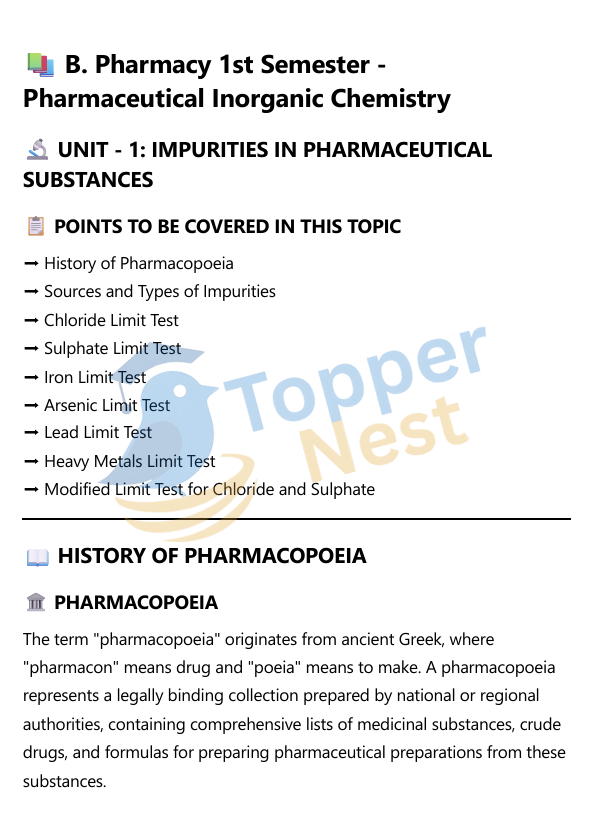When it comes to medicines, even the tiniest impurity can make a big difference. Whether it affects the drug’s safety, stability, or effectiveness, impurities in pharmaceutical substances are a serious concern in the healthcare industry.
In this article, we’ll explore where these impurities come from, how they are detected, and why it’s important to control them. You’ll also get to know about standard limit tests used to identify harmful substances like chloride, sulphate, iron, arsenic, lead, and heavy metals — all guided by the official pharmacopoeias.

what are Impurities
Impurities are unwanted chemical substances that exist in a drug substance or product. They’re not the drug’s active ingredient or an excipient, and their presence can compromise the drug’s quality, safety, and efficacy. All drug manufacturers must control impurities to ensure the final product is safe for patient use.
Types of Impurities
According to the International Conference on Harmonisation (ICH) guidelines, impurities are categorized into three main types:
- Organic Impurities: These are substances that arise from the drug’s manufacturing process or degradation.
- Inorganic Impurities: These are non-carbon-based impurities, usually originating from the manufacturing process.
- Residual Solvents: These are volatile organic chemicals used during the manufacturing process that aren’t completely removed. The ICH classifies solvents into three classes based on their toxicity.
History of Pharmacopoeia
Pharmacopoeias are official publications that define the quality standards of drugs, including their purity, strength, and testing methods.
Historically, pharmacopoeias have evolved to ensure uniformity and safety in pharmaceutical preparations. The major pharmacopoeias used in India include:
- Indian Pharmacopoeia (IP)
- British Pharmacopoeia (BP)
- United States Pharmacopoeia (USP)
Properties and Medicinal Uses of Inorganic Compounds
Inorganic compounds, which include metals, salts, and non-metals, are a cornerstone of pharmaceutical science. Their unique chemical properties allow them to be used for a wide range of therapeutic and diagnostic purposes. Unlike many organic drugs that act on specific receptors, inorganic compounds often function through different mechanisms, such as forming complexes, participating in redox reactions, or acting as essential cofactors.
Properties of Inorganic Compounds
The properties of inorganic compounds make them particularly suitable for medicinal applications:
- Diverse Reactivity: Metals and other inorganic elements can exhibit various oxidation states and coordination geometries, allowing them to interact with a wide range of biological molecules like proteins and DNA. This diversity is crucial for designing drugs with specific targets.
- Unique Physical Properties: Many inorganic compounds have distinct physical properties, such as being colored or magnetic, which can be leveraged in diagnostic imaging. For example, some metal complexes are used as contrast agents in MRI scans.
- Essential Biological Roles: Many inorganic ions are vital for life. For instance, iron is a core component of hemoglobin, and zinc is a cofactor for hundreds of enzymes. When the body has a deficiency, these inorganic compounds are used as supplements.
- Redox Activity: Many transition metals can easily be oxidized and reduced, making them crucial for metabolic processes. This property is also exploited in drug design to target specific cellular pathways.
Medicinal Uses of Inorganic Compounds
Inorganic compounds have a rich history in medicine and continue to be a vital part of modern pharmacology.
1. Gastrointestinal Agents
- Antacids: Compounds like aluminum hydroxide (Al(OH)3) and magnesium hydroxide (Mg(OH)2) are alkaline and work by neutralizing excess stomach acid, providing relief from indigestion and heartburn.
- Laxatives: Magnesium sulfate (MgSO4) and other saline cathartics draw water into the intestines, increasing stool volume and promoting defecation.
- Antimicrobials: Bismuth subsalicylate (C7H5BiO4) is used to treat gastrointestinal infections and diarrhea due to its antimicrobial and anti-inflammatory properties.
2. Anticancer Agents
- Cisplatin ([Pt(NH3)2Cl2]): One of the most famous inorganic drugs, cisplatin is a platinum-based compound used to treat various cancers, including testicular, ovarian, and lung cancer. It works by binding to and cross-linking DNA, which inhibits DNA replication and leads to cell death.
3. Electrolytes and Supplements
- Iron Salts: Ferrous sulfate (FeSO4) is a common iron supplement used to treat or prevent iron-deficiency anemia, as iron is essential for the production of hemoglobin.
- Calcium Salts: Calcium carbonate (CaCO3) is used to treat calcium deficiencies, which can lead to osteoporosis.
- Electrolyte Replenishment: Sodium, potassium, and chloride ions are crucial for maintaining fluid balance and nerve function. They are administered via oral rehydration solutions or intravenous fluids to treat dehydration.
4. Diagnostic and Radiopharmaceuticals
- Radiopharmaceuticals: Technetium-99m (99mTc) is a widely used radioisotope in diagnostic imaging. It is a gamma-emitter that can be attached to other molecules to visualize specific organs, such as the heart or brain.
- MRI Contrast Agents: Gadolinium-based complexes are used to enhance the clarity of images obtained during magnetic resonance imaging (MRI) by altering the magnetic properties of water molecules in the body.
5. Other Therapeutic Uses
- Psychiatric Disorders: Lithium carbonate (Li2CO3) is a mood stabilizer used to treat bipolar disorder. Its mechanism involves interfering with neuronal signaling pathways.
- Antiseptics and Astringents: Compounds like potassium permanganate (KMnO4) and zinc oxide (ZnO) are used topically. Potassium permanganate is a potent oxidizing agent used for wound cleansing, while zinc oxide has astringent and soothing properties for skin irritations.
FAQs – Impurities in Pharmaceutical Substances
1. Why is it important to test for impurities in drugs?
To ensure safety, quality, and effectiveness of pharmaceutical products. Impurities, even in small quantities, can be toxic or reduce drug activity.
2. What does the limit test tell us?
The limit test indicates whether an impurity is within permissible levels as defined by the pharmacopoeia.
3. What is the purpose of an assay?
An assay determines the exact amount of active pharmaceutical ingredient (API) in a sample. It ensures the correct dose is delivered to the patient.
4. Are all impurities harmful?
Not necessarily. Some impurities are harmless in trace amounts, but pharmacopoeial standards ensure that only safe limits are allowed.
